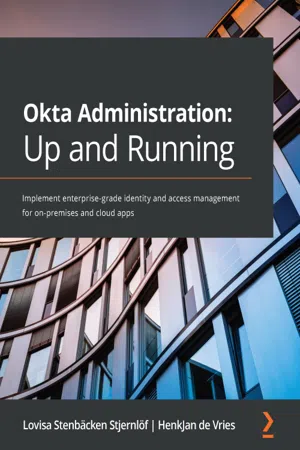
- 268 pages
- English
- ePUB (mobile friendly)
- Available on iOS & Android
Okta Administration: Up and Running
About This Book
Plan, design, and implement identity and access management solutions with OktaKey Features• Learn how to use Okta for complete identity and access management in your organization• Use single sign-on, multifactor authentication, and life cycle management for enhanced security• Set up, manage, and audit API access policiesBook DescriptionIAM, short for identity and access management, is a set of policies and technologies for ensuring the security of an organization through careful role and access assignment for users and devices. With this book, you'll get up and running with Okta, an identity and access management (IAM) service that you can use for both employees and customers. Once you've understood how Okta can be used as an IAM platform, you'll learn about the Universal Directory, which covers how to integrate other directories and applications and set up groups and policies. As you make progress, the book explores Okta's single sign-on (SSO) feature and multifactor authentication (MFA) solutions. Finally, you will delve into API access management and discover how you can leverage Advanced Server Access for your cloud servers and Okta Access Gateway for your on-premises applications. By the end of this Okta book, you'll have learned how to implement Okta to enhance your organization's security and be able to use this book as a reference guide for the Okta certification exam.What you will learn• Understand different types of users in Okta and how to place them in groups• Set up SSO and MFA rules to secure your IT environment• Get to grips with the basics of end-user functionality and customization• Find out how provisioning and synchronization with applications work• Explore API management, Access Gateway, and Advanced Server Access• Become well-versed in the terminology used by IAM professionalsWho this book is forIf you are an IT consultant, business decision-maker, system administrator, system and security engineer, or anyone who wishes to use Okta to plan, design, and implement identity and access management solutions, this book is for you. A basic understanding of authentication and authorization is necessary.
Frequently asked questions
Information
Section 1: Getting Started with Okta
- Chapter 1, IAM and Okta
- Chapter 2, Working with Universal Directory
- Chapter 3, Single Sign-On for a Great End User Experience
- Chapter 4, Increasing Security with Adaptive Multi-Factor Authentication
- Chapter 5, Automating Using Life cycle Management
- Chapter 6, Customizing Your Okta GUI
Chapter 1: IAM and Okta
- The origins of Okta
- Exploring Okta
- Okta's basic features
- Okta's advanced features
Exploring the origins of Okta
Understanding IAM and Okta
- Manage the roles of individual users within an organization.
- Manage the privileges they have to access company resources while using context.
- Configure scenarios to determine whether access is granted or denied.
- It orchestrates the user's life cycle during their time within the company.
- It is constantly determined whether access is allowed within company policies and rules to gain access to needed resources, content, and data, using the best available security features.
Exploring Okta
- A password vault to store and maintain access to applications and systems. This can be advanced by using protocols that allow Single Sign-On (SSO).
- Provisioning integrations to create and manage user identities within directories, applications, databases, and infrastructure.
- Security enforcement applications to secure access to applications, as well as securing the data of these systems and others.
- Unified reporting systems that allow fine-grained insight into the array of tools to create oversight and better knowledge of what is happening within and outside of the corporate network.
Table of contents
- Okta Administration: Up and Running
- Why subscribe?
- Preface
- Section 1: Getting Started with Okta
- Chapter 1: IAM and Okta
- Chapter 2: Working with Universal Directory
- Chapter 3: Single Sign-On for a Great End User Experience
- Chapter 4: Increasing Security with Adaptive Multi-Factor Authentication
- Chapter 5: Automating Using Life Cycle Management
- Chapter 6: Customizing Your Okta GUI
- Section 2: Extending Okta
- Chapter 7: API Management
- Chapter 8: Managing Access with Advanced Server Access
- Chapter 9: Leveraging Access Gateway for Your On-Premises Applications
- Other Books You May Enjoy